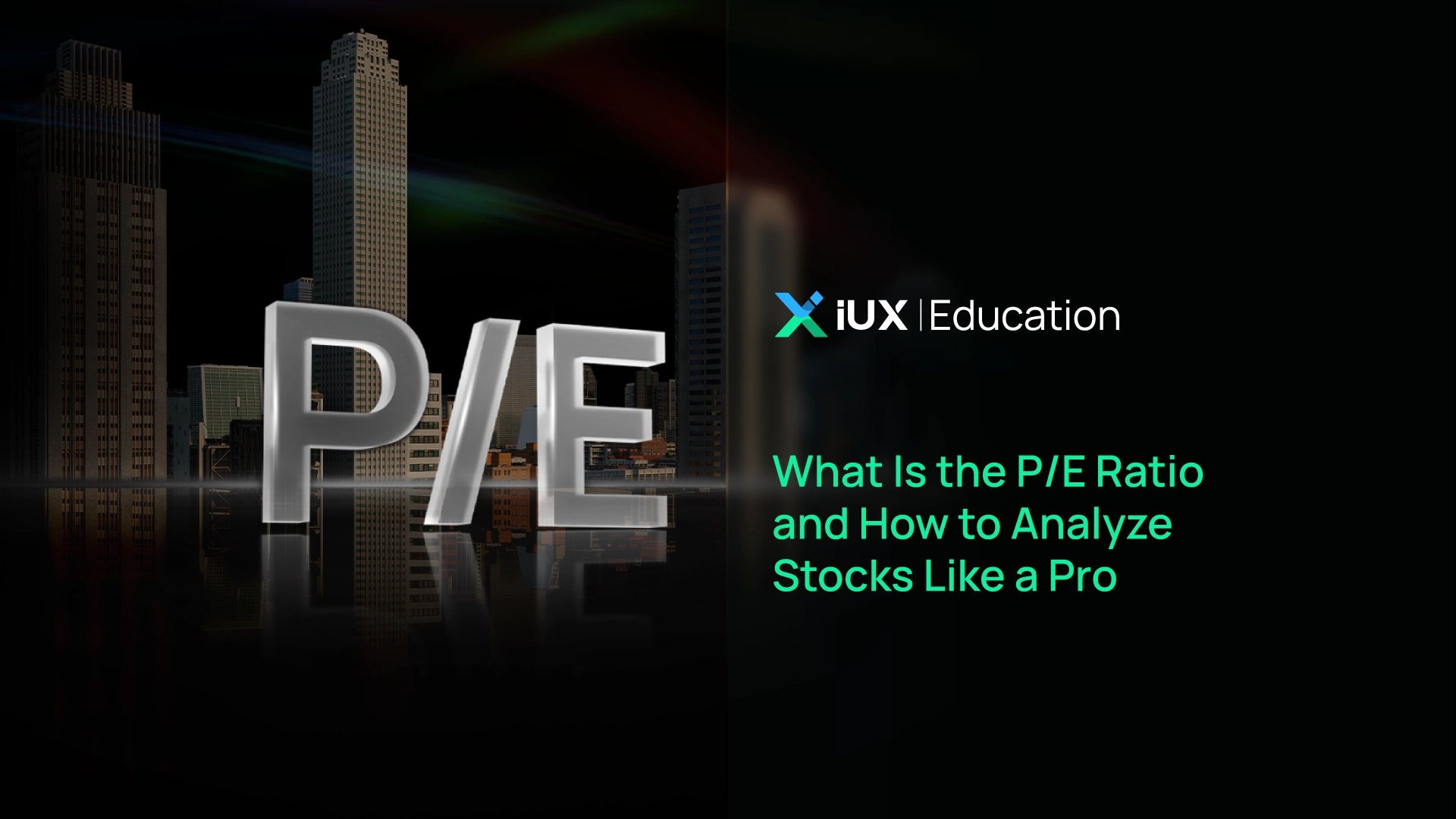CFDs are complex instruments and come with a high risk of losing money rapidly due to leverage. 76% of retail investor accounts lose money when trading CFDs with this provider. You should consider whether you understand how CFDs work and whether you can afford to take the high risk of losing your money.
CFDs are complex instruments and come with a high risk of losing money rapidly due to leverage. 76% of retail investor accounts lose money when trading CFDs with this provider. You should consider whether you understand how CFDs work and whether you can afford to take the high risk of losing your money.

What Is the P/E Ratio and How to Analyze Stocks Like a Pro
What Is the P/E Ratio?
Many investors and market analysts often mention the term "P/E" or "Price-to-Earnings Ratio." Simply put, it’s calculated by dividing a stock’s price by its earnings per share (EPS). Or to make it even easier to understand—it tells you how many baht you’re paying to earn 1 baht in profit per year from that stock.
But where does EPS come from?
EPS, or Earnings Per Share, is a key indicator showing how much net profit a company earns for each outstanding common share during a certain period (usually yearly or quarterly). It’s calculated with the following formula:
EPS = Net profit ÷ Number of outstanding common shares
Example:
Let’s say Company A earns a net profit of 100 million USD in a year and has 20 million common shares.
EPS = 100,000,000 ÷ 20,000,000 = 5 USD per share
Once you have the EPS, you can calculate the P/E like this:
If Company A’s stock is trading at 50 USD and its EPS is 5 USD per share (based on the past year),
P/E = 50 ÷ 5 = 10 times
This means that if the company continues earning at the same rate, it would take 10 years to recover your investment.
Is a Low P/E Always a Bargain?
Many people assume that a low P/E means the stock is cheap—and that it’s an immediate buy. But that’s not always the case. A low P/E doesn’t automatically mean a stock is undervalued. Sometimes, it actually reflects uncertainty about the company’s earnings or concerns about its future.
For example, a company might report unusually high profits in a single year because it sold off an asset. That one-time gain can inflate its EPS for the year, making the P/E ratio look artificially low. But in the following year, if the company can’t replicate those profits, investor demand might fall, the stock price could stagnate, and the P/E will still appear low—even though the business fundamentals may not be solid at all.
What About a High P/E? Does It Mean the Stock Is Overpriced?
A high P/E ratio doesn’t always mean a stock is overpriced—it could actually reflect strong investor expectations.
This is especially common with tech companies, innovative businesses, or growth stocks, where investors believe the company’s future earnings will grow rapidly. Because of this optimism, they’re willing to pay a high price today for the potential of strong profits tomorrow.
For example:
Let’s say Company B has an EPS of 5 USD, but the stock is priced at 100 USD. That gives it a P/E of 20—meaning it would take 20 years to recover your investment if earnings stayed the same.
That might sound extreme, but companies in breakthrough industries often see exponential growth.Tech companies like Nvidia or Amazon have traded at P/Es above 50 due to strong future growth expectations. If Company B doubles its earnings next year to 10 USD per share and continues that growth trend, the P/E will naturally decline over time—unless the stock price rises to match the earnings growth.
How to Use the P/E Ratio Effectively When Analyzing Stocks
-
Compare P/E with companies in the same industry
Companies in the same sector usually have similar P/E ranges. For example, banks often trade at a P/E between 8–12. So if one bank stock has a P/E of just 5, it’s worth asking: “Why is it so cheap?” There may be a reason behind it—positive or negative.
-
Compare with the company’s historical P/E
If a stock’s 5-year average P/E is 20, but it’s currently at 12, that could be an opportunity—or it might signal that the company is facing some challenges. Looking at past P/E trends helps put the current valuation in context.
-
Use Forward P/E for a growth outlook
Forward P/E uses the stock’s current price divided by forecasted future earnings. It helps investors understand how the market views the company’s growth potential. This is especially useful for growth stocks where earnings are expected to rise significantly.
Advanced Analysis Tip: Break Down P and E Separately
-
If the stock price (“P”) rises quickly but the company’s earnings (“E”) haven’t grown yet, it often means the market is reacting to “hype” or undergoing a re-rating—a situation where investors start assigning a higher valuation based on future expectations, even with limited information.
-
On the other hand, if earnings (“E”) are steadily growing but the P/E ratio is dropping, it means the stock price hasn’t caught up with the company’s actual performance. This can indicate that the stock is still undervalued.
That’s why professional investors don’t just look at the P/E number alone. They analyze the relationship between Price (P) and Earnings (E) to understand what’s really driving the valuation.
IUX is a platform designed for investors at all levels—from beginners to professionals. With its user-friendly interface, comprehensive tools, and fast execution, IUX ensures you never miss an investment opportunity, whether you're focused on value stocks or growth stocks.
Open your IUX account today and start building your investment portfolio with greater confidence and efficiency.
Value Stocks vs. Growth Stocks: How Do They Use P/E Differently?
-
Value Stocks typically have low P/E ratios. They appeal to investors who prefer buying undervalued shares with solid fundamentals. Examples include energy stocks and banking stocks—companies that are stable and generate steady earnings.
-
Growth Stocks, on the other hand, usually have high P/E ratios because investors expect strong future earnings growth. These often include tech companies, healthcare innovators, and businesses focused on cutting-edge innovation.
So How Do You Know What P/E Is “Right”?
There’s no fixed rule for what makes a P/E ratio “appropriate,” but here are some general guidelines:
-
P/E below 10: Could be attractive, but you need to check whether the company’s earnings are sustainable.
-
P/E between 10–20: This is the typical range for many industries and is often considered a healthy average.
-
P/E above 30: Common in high-growth stocks, but it might also suggest the stock is overvalued or priced too optimistically.
A Practical Method: Estimate the Target Price Using This Formula
Let’s say you expect Company B to earn 2 USD per share (EPS) next year, based on past performance.
You also believe the stock deserves a P/E ratio of 15, based on the industry average or the company’s quality.
Using the formula:
Target Price = EPS × P/E
Target Price = 2 × 15 = 30 USD
If the stock is currently trading at 20 USD, and your assumptions hold true, the price could rise to 30 USD—offering a potential 50% upside, which makes it an attractive investment opportunity.
The P/E ratio is just one tool for evaluating a stock’s value. To invest with confidence and accuracy, you need to consider both today’s stock price and the company’s future earnings potential. Don’t focus only on whether the number is high or low—always ask yourself: Is this valuation truly reasonable for this particular business?
Note: This article is intended for preliminary educational purposes only and is not intended to provide investment guidance. Investors should conduct further research before making investment decisions.


